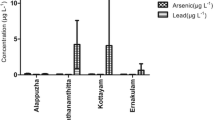Abstract
Element contents of teeth elucidate exposure nature, but less is known about association of tooth element concentrations of diabetics and hypertensives with exposure profile. Present study aims to estimate copper, chromium, iron, zinc, nickel, and lead concentrations in the permanent teeth of control, diabetic, and hypertensive subjects from Mysore. The results show that lead levels of teeth (Pb-T) are higher in the hypertensives and diabetics, whereas copper levels of teeth (Cu-T) are lower in the hypertensives and users of stainless steel utensils than that of controls and users of mixed utensils. The elevated Cu-T levels found in the users of mixed utensils that being made of several metals are ascribed to leaching effect of sour and spicy food of Indian cuisine. The element levels were influenced by diet (Zn-T), place of living, sex and income (Pb-T) of the subjects, but not by age, drinking water from different sources, and certain habits viz., smoking, alcohol consumption, chewing betel, and nut. Thus, it is evident that high Pb-T and low Cu-T levels may be related with diabetes and hypertension and high Pb-T and Cu-T levels, respectively, in the urbanites, and the users of mixed utensils may show different exposure profiles from environment and utensils.
Similar content being viewed by others
References
Nowak B. Occurrence of heavy metals and sodium, potassium and calcium in human teeth. Analyst. 1995;120(3):747–50.
Sukumar A, Subramanian R (1999) Characterization of human teeth for trace elements. Proceedings of the second National Workshop on Development and use of Reference Materials. LATS/15/2000. Central Pollution Control Board, Delhi, pp:86-88
Arora M, Kenedy BJ, Elhlou S, Pearson NJ, Walker DM, Bayl P, et al. Spatial distribution of lead in human primary teeth as a biomarker of pre- and neonatal lead exposure. Sci Total Environ. 2006;371(1–3):55–62.
Malara P, Kwapulinski J, Malara B. Do the levels of selected metals differ significantly between the roots of carious and non-carious teeth? Sci Total Environ. 2006;369(1–3):59–68.
Wilhelm M, Ewers U, Wittsiepe J, Furst P, Holzer J, Eberwein G, et al. Human biomonitoring studies in North Rhine-Westphalia, Germany. Int J Hyg Environ Health. 2007;210(3–4):307–18.
Haavikko K, Anttila A, Helle A, Vuori E. Lead concentrations of enamel and dentine of deciduous teeth of children from two Finnish towns. Arch Environ Health. 1984;39(2):78–84.
Lane DW, Peach DF. Some observations on the trace element concentrations in human dental enamel. Biol Trace Elem Res. 1997;60(1–2):1–11.
Grandjean P, Jorgensen PJ. Retention of lead and cadmium in prehistoric and modern human teeth. Environ Res. 1990;53(1):6–15.
Rabinowitz MB, Wang JD, Soong WT. Dentine lead and child intelligence in Taiwan. Arch Environ Health. 1991;46(6):351–60.
Nriagu J, Burt B, Linder A, Ismail A, Sohn W. Lead levels in blood and saliva in a low-income population of Detroit, Michigan. Int J Hyg Environ Health. 2006;209(2):109–21.
Haavikko K, Anttila A, Helle A, Pesonen E. Atherosclerosis precursors in Finnish children and adolescents. XIV. Zinc and copper concentrations in deciduous teeth. Acta Paediatr Scand Suppl. 1985;318:213–219.
Scharer K, Veits G, Brockhaus A, Ewers U. High lead content of deciduous teeth in chronic renal failure. Pediatr Nephrol. 1991;5(6):704–7.
Winneke G, Altmann L, Kramer U, Turfeld M, Behler R, Gutsmuths FJ, et al. Neurobehavioral and neurophysiological observations in six year old children with low lead levels in East and West Germany. Neurotoxicol. 1994;15(3):705–13.
Gomes VE, Rosario de Sousa Mda L, Barbosa F Jr, Krug FJ, Pereira Saraiva Mda C, Cury JA, et al. In vivo studies on lead content of deciduous teeth superficial enamel of preschool children. Sci Total Environ. 2004;320(1):25–35.
Anderson RA. Chromium and diabetes. Nutrition. 1999;15(9):720–22.
Rabinovitz H, Friedensohn A, Leibovitz A, Gabay G, Rocas C, Habot B. Effect of chromium supplementation on blood glucose and lipid levels in type 2 diabetes mellitus elderly patients. Int J Vitam Nutr Res. 2004;74(3):178–182.
Sukumar A, Subramanian R. Trace elements in scalp hair of manufacturers from Sivakasi, Tamilnadu. Sci Total Environ. 1992;114:161–168.
Brown CJ, Chenery SR, Smith B, Tomkins A, Roberts GJ, Sserunjogi L, et al. A sampling and analytical methodology for dental trace element analysis. Analyst. 2002;127(2):19–23.
Subramanian R, Sukumar A. Biological reference materials and analysis of elements. Fresenius Z Anal Chem. 1988;332:623–626.
Okamoto K. Preparation and certification of human hair powder reference material. Clin Chem. 1985;31(10):1952.
Tvinnereim HM, Eide R, Riise T, Fosse G, Wesenberg GR. Zinc in primary teeth from children in Norway. Sci Total Environ. 1999;226(2–3):201–12.
Rahman A, Maqbool E, Zuberi HS. Lead-associated deficits in stature, mental ability and behaviour in children in Karachi. Ann Trop Paediatr. 2002;22(4):301–311.
Hernandez-Guerrero JC, Jimenez-Farfan MD, Belmont R, Ledesma-Montes C, Baez A. Lead levels in primary teeth of children living in Mexico City. Int J Paediatr Dent. 2004;14(3):175–81.
Brown CJ, Chenery SR, Smith B, Mason C, Tomkins A, Roberts GJ, et al. Environmental influences on the trace element content of teeth-implication for disease and nutritional status. Arch Oral Biol. 2004;49(9):705–717.
Adams JB, Romdalvik J, Ramanujam VM, Legator MS. Mercury, lead, and zinc in baby teeth of children with autism versus controls. J Toxicol Environ Health. 2007;70(12):1046–1051.
Al-Mahroos F, al-Saleh FS. Lead levels in deciduous teeth of children in Bahrain. Ann Trop Paediatr. 1997;17(2):147–154.
Karahalil B, Aykanat B, Ertas N. Dental lead levels in children from two different urban and suburban areas of Turkey. Int J Hyg Environ Health. 2007;210(2):107–12.
Fischer A, Kwapulinski J, Wiechula D, Fischer T, Loska M. The occurrence of copper in deciduous teeth of girls and boys living in Upper Silesian industry region (Southern Poland). Sci Total Environ. 2008;389(2–3):315–9.
Alomary A, Al-Momani IF, Massadeh AM. Lead and cadmium in human teeth from Jordan by atomic absorption spectrometry: Some factors influencing their concentrations. Sci Total Environ. 2006;369(1–3):69–75.
Youravong N, Chongsuvivatwong V, Teanpaisan R, Geater AF, Dietz W, Dahlen G, et al. Morphology of enamel in primary teeth from children in Thailand exposed to environmental lead. Sci Total Environ. 2005;348(1–3):73–81.
Gulson BL. Tooth analyses of sources and intensity of lead exposure in children. Environ Health Perspect. 1996;104(3):306–12.
Omar M, Ibrahim M, Assem H, Moustafa Y, Batgtah F. Teeth and blood lead levels in Egyptian schoolchildren: relationship to health effects. J Appl Toxicol. 2001;21(4):349–52.
Costa de Almeida GR, Pereira Saraiva Mda C, Barbosa F Jr, Krug FJ, Cury JA, de Sousa R, et al. Lead contents in the surface enamel of deciduous teeth sampled in vivo from children in uncontaminated and in lead-contaminated areas. Environ Res. 2007;104(3):337–45.
Begerow J, Freier I, Turfeld M, Kramer U, Dunemann L. Internal lead and cadmium exposure in 6-year-old children from western and eastern Germany. Int Arch Occup Environ Health. 1994;66(4):243–8.
Acknowledgments
The authors, A.Sukumar and G. Nagaraj, thank Professor G.T. Bhandage, Principal, Regional Institute of Education, [NCERT], Mysore for encouragement and the facilities provided. Special thanks are owed to the sample donors of the study and Professor K. Okamoto, National Institute of Environmental Studies, Japan for supply of the CRM.
Author information
Authors and Affiliations
Corresponding author
Rights and permissions
About this article
Cite this article
Nagaraj, G., Sukumar, A., Nandlal, B. et al. Tooth Element Levels Indicating Exposure Profiles in Diabetic and Hypertensive Subjects from Mysore, India. Biol Trace Elem Res 131, 255–262 (2009). https://doi.org/10.1007/s12011-009-8371-4
Received:
Accepted:
Published:
Issue Date:
DOI: https://doi.org/10.1007/s12011-009-8371-4




